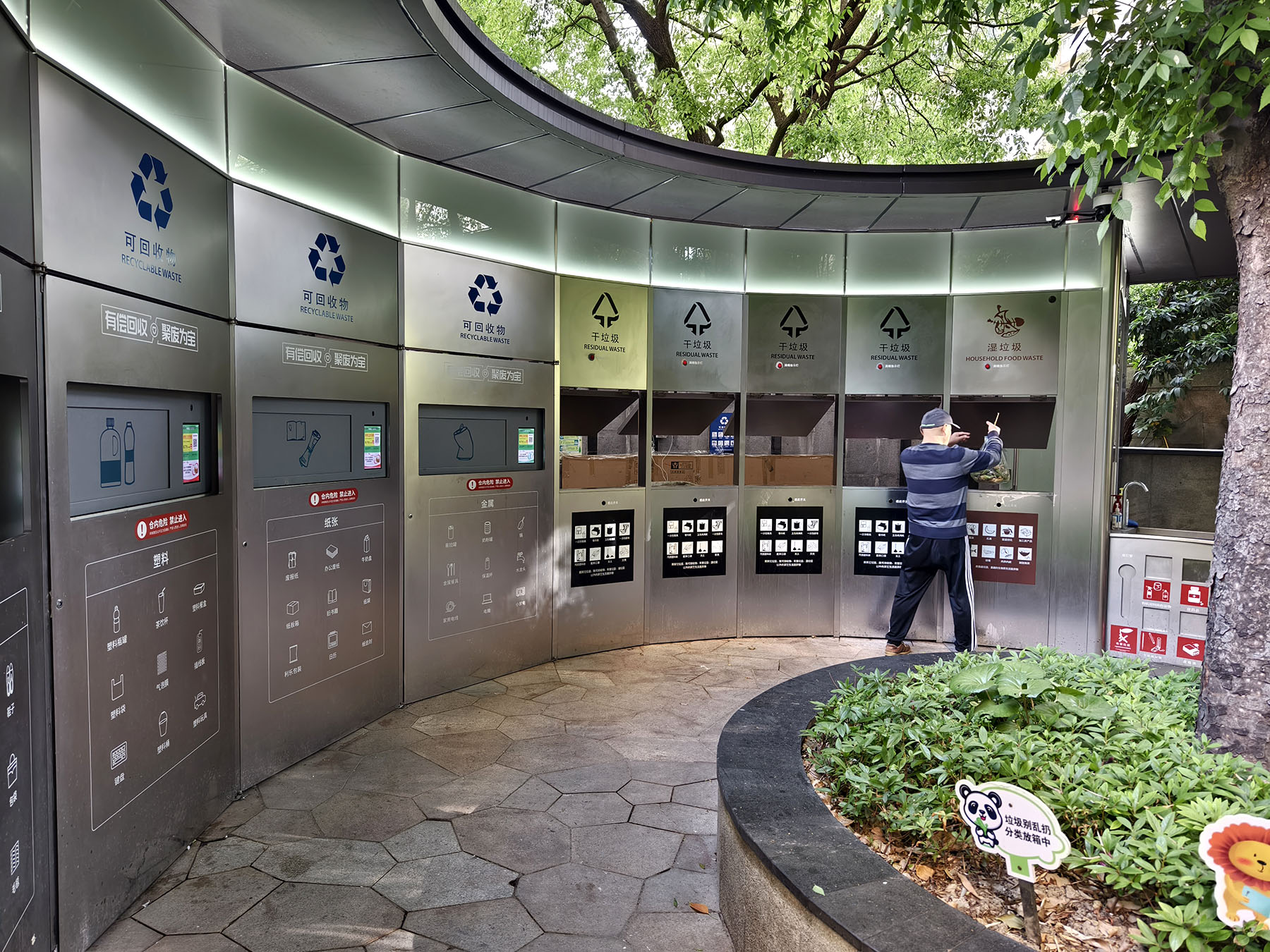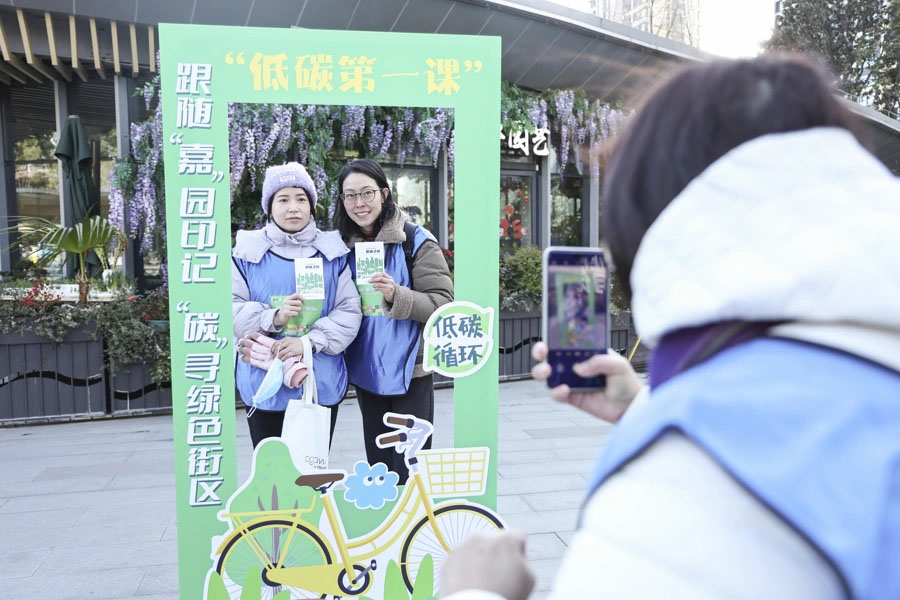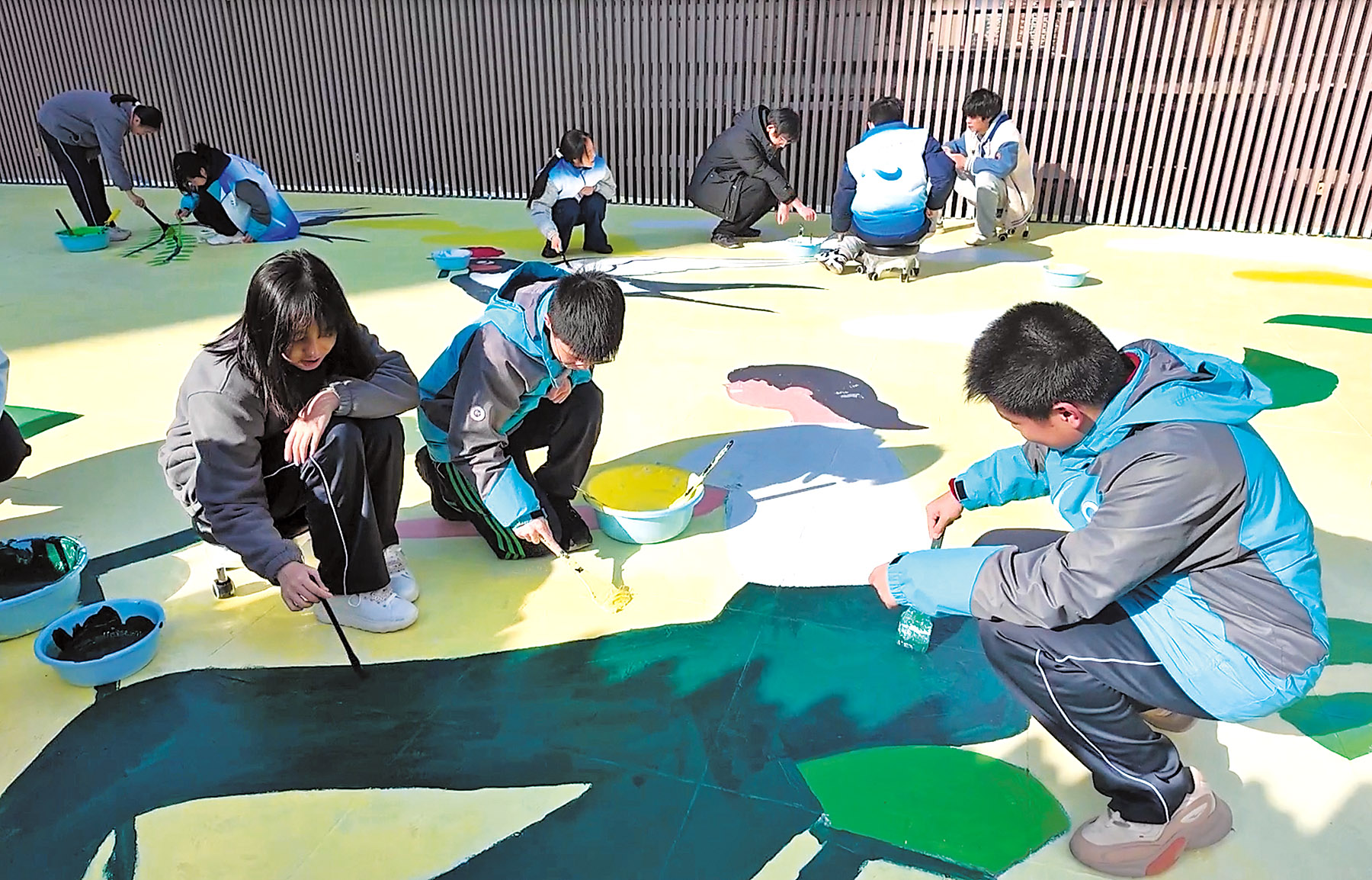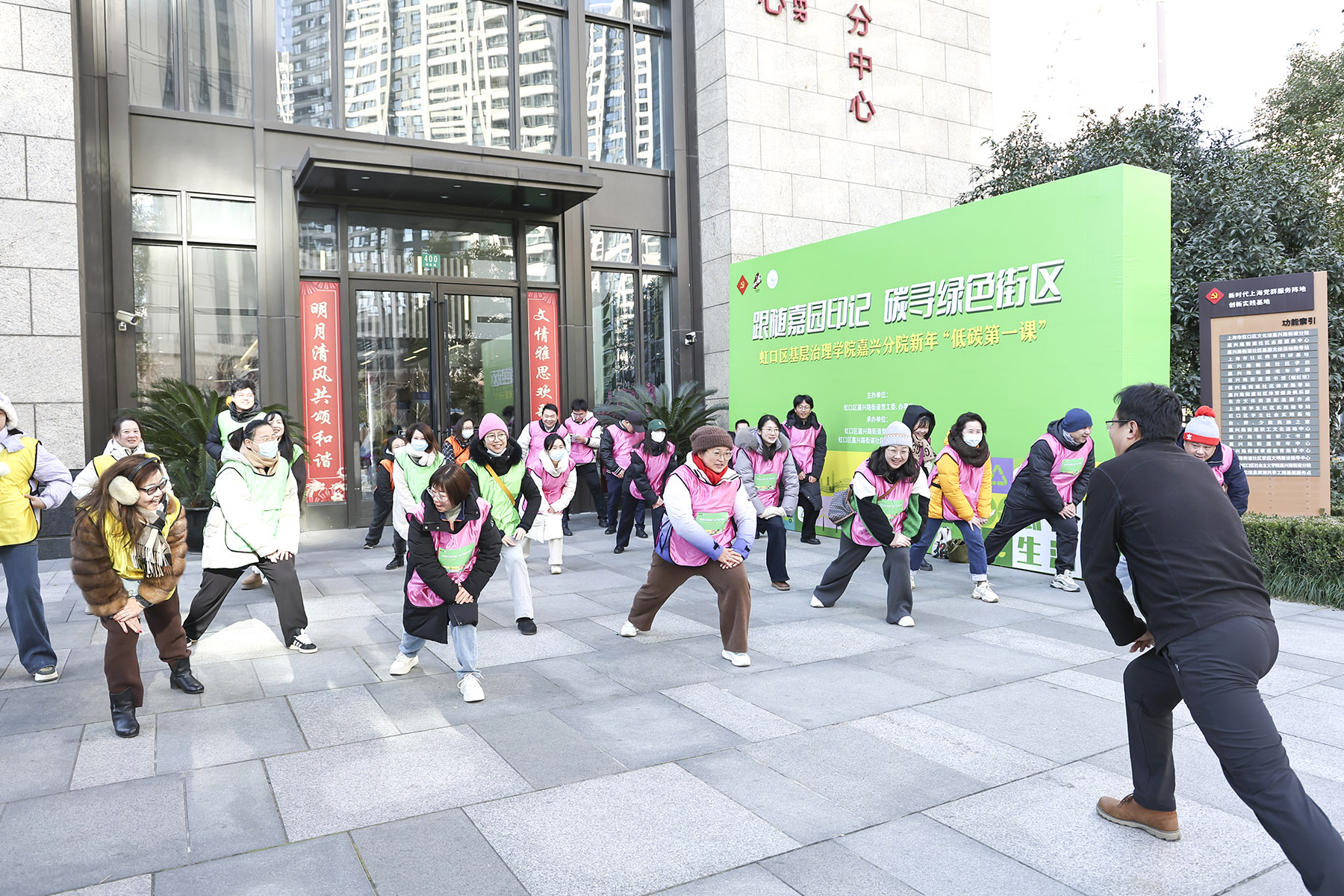Shanghai pilot program develops into leading example of cleaner, greener living

After years of daily practice, Shanghai resident Hou Yufeng believes household waste sorting has almost become a "muscle memory" for him and his neighbors.
They routinely drain and bag food waste, putting the refuse into the correct bin and then disposing of the bag in a general waste bin. Delivery boxes are also folded and sorted for disposal.
Even Hou's two children, aged 10 and 13, take the initiative to remind residents to separate hazardous waste.
Hou lives in one of the 84 residential compounds in Jiaxing Road subdistrict in Hongkou district, where President Xi Jinping, who is also general secretary of the Communist Party of China Central Committee and chairman of the Central Military Commission, first promoted the trend of trash sorting in November 2018.
READ MORE: Green fashion turns old plastics into profits
Years later, in a letter of reply dated May 21, 2023, to volunteers engaged in trash sorting in the subdistrict, Xi expressed his hope that they could continue to play a unique role in grassroots governance, and encouraged more residents to develop the habit of sorting trash.
"The daily routine of waste sorting, although seen as a troublesome task by many in the first days, has evolved into a small thing to be so proud of over the years," Hou said.
He believes waste sorting is a window for people to observe urban governance and see the progress of society. "That's why we have witnessed residents' shift in mindset from mandatory sorting to voluntary compliance — even encouraging others to sort waste," he said.
Hou is a waste sorting volunteer, whose duty is to interact with residents and remind them of which bin to use to dispose of particular waste.
The enthusiasm for waste sorting in the municipality extends beyond residential compounds to restaurants, hotels, commercial areas, and office buildings.
Shanghai's residential compounds and other institutions achieved a sorting compliance rate of over 95 percent last year, Shanghai Landscaping and City Appearance Administrative Bureau data showed.
The high compliance rate has been achieved for a number of consecutive years. Before waste sorting became compulsory in July 2019, the compliance rate was 15 percent.
"In our subdistrict, the amount of kitchen waste and recyclables has been increasing year by year, leading to a reduction in the daily volume of general waste being incinerated for energy generation," said Tian Hongyi, who is in charge of rubbish sorting at Jiaxing Road subdistrict.
"From a societal perspective, waste sorting is about easing the burden on the city's waste management system and safeguarding nature," she said.

Participation urged
In his letter of reply, Xi said he was glad to learn that after recent years of promoting trash sorting, the community had made new progress, while residents' civility had been enhanced, and the environment had become more beautiful.
Earlier, volunteer representatives from the subdistrict had written to Xi, reporting their achievements in trash sorting, and expressing their determination to make greater contributions to promoting waste sorting and disposal.
Noting that sorting and recycling trash is a systematic project that requires concerted, long-term efforts from all parties, Xi called for precise measures and active participation of the masses.
He also said that the volunteers could continue to contribute to promoting the construction of an ecological civilization and improving the level of civilization among the whole of society.
In July 2019, Shanghai became China's first city to make sorting household waste compulsory. Since then, waste sorting efforts in China have progressed, with roughly 300 cities implementing mandatory household and workplace waste sorting to date, achieving a coverage rate of 82.5 percent in residential communities.
In Xiamen, Fujian province, the rate of recyclable waste recovery has increased from 25 percent in 2017 to 54 percent today, with the resource utilization rate of waste leaping from 44 percent to 90 percent.
In Ningbo, Zhejiang province, the separation rate of kitchen waste rose to 28 percent last year, with both the resource utilization rate of waste and safe treatment rate of waste reaching 100 percent.
The Jiaxing Road subdistrict volunteers said that the letter of reply from Xi was recognition of their work, and guided them to continue moving forward.

Innovative approach
Given the high mobility of residents, the large number of renters, and the diverse expat population at Hou's apartment complex — which is home to over 1,000 residents — the volunteers created a bilingual manual in Chinese and English for newcomers.
It includes tips on how waste sorting is conducted in Shanghai, and gives the waste collection locations in the residential compound.
The volunteers try to involve students as much as possible in the work. They explain information and key points about garbage sorting to the students who sometimes join the volunteers at the garbage collection stations for an hour to observe the process.
"With hands-on experience, the youngsters can experience the entire process of garbage sorting close-up, thereby promoting the formation of such habits in the entire family," said Hou, 42, who is chairman of a medical technology enterprise.
Cui He from the social work office in the subdistrict, said collaboration with some enterprises had allowed residents to witness the tangible benefits of their waste sorting efforts. These enterprises have transformed recycled milk cartons into tables and chairs, which Cui's team placed in public spaces to motivate residents to continue their efforts.
Also guided by Xi's letter of reply, renovation of a waste collection station was completed in December in Hou's complex.
Open waste bins were transformed into a smart waste collection station with a metallic appearance, unique curved design, and rain covers fitted with solar panels. The renovated station is a modern and aesthetically pleasing addition to the residential compound.
"This waste collection station is equipped with a range of high-tech features, including sensor-operated doors — which only open when someone approaches — to reduce odor emissions, waste amount identification and alerts, and detection and notification of misplaced waste items," said Tian, who is in charge of trash sorting.
In terms of functionality, the waste collection station further categorizes recyclable waste into five types — glass, metal, plastic, paper, and textiles — beyond the general four categories: kitchen waste, recyclables, hazardous waste and general waste. Hazardous waste is divided into five types for separate disposal: light bulbs, batteries, medicines, mercury-containing waste, and organic solvent packaging.
The exterior of each bin is clearly labeled and has illustrations indicating the specific waste items to be deposited there. For instance, the bin for metal waste specifies items such as aluminum cans, milk powder tins, pots, metal cutlery, thermos bottles, faucets, computers, and small home appliances.
"Waste sorting teaches us about a more refined attitude toward life. By treating each piece of waste seriously, we are essentially reevaluating our relationship with material goods," said Hou.
In 2024, the city's daily recyclable waste recovery and hazardous waste separation reached nearly 8,000 metric tons and 2 tons, respectively, according to the Shanghai Landscaping and City Appearance Administrative Bureau.
Daily kitchen waste separation reached more than 9,200 tons per day, processed mostly through anaerobic digestion for biogas production and heating, with aerobic composting making up a small proportion of the amount.
In response to some public concerns about the convenience of waste disposal and the cleanliness of the environment, Shanghai carried out widespread face-lifts and upgrades of waste collection stations in residential compounds last year, the bureau said. In 2023, a total of 347 high-quality waste sorting locations had been established as exemplary projects within the apartment complexes.

Low-carbon lifestyle
In Jiaxing Road subdistrict, where residents have largely adopted waste sorting habits, the role of volunteers has evolved to also include organizing a range of activities centered around low-carbon living.
Residents have been urged to jog regularly as a way to encourage "green travel", and to produce public works of art promoting a low-carbon lifestyle.
In January, the roof of a public service building in the subdistrict took on a new look. Supervised by an artist, 120 middle school students painted an image covering 200 square meters showing a woman riding a bicycle, and swallows carrying tree branches and flowers.
The volunteers have also organized flea markets for the exchange of old items to promote a low-carbon lifestyle.
Hou said both of his children have been to the flea markets, and exchanged unused small home appliances for potted plants, and clothing for handmade crafts. Such activities nurture environmental awareness in the community, he said.
"My children can not only sort waste accurately, but they also water plants with water from rice washing, and use old towels as cleaning rags. They understand the value of resources," said Hou.
ALSO READ: China to implement garbage sorting in all cities by 2025
He carries reusable bags when shopping, refuses disposable utensils when ordering food online, and buys his children toys made from recycled materials.
Tian said one of their aims this year is to award carbon credits to residents based on the volume of waste sorted, and provide discounts on electricity bills.
Another objective is to process kitchen waste within the residential compound, with the installation of a kitchen waste treatment facility that converts waste into organic fertilizer for plants in the apartment complex.
President Xi has paid much attention to green, circular and low-carbon development, and has made multiple instructions on the issue.
Contact the writer at zhouwenting@chinadaily.com.cn


